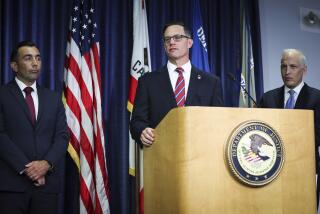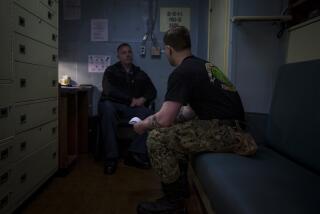Tech Goes to War
- Share via
It’s raining.
From a blue leather La-Z-Boy on the bridge of the Bonhomme Richard, Navy Capt. Stan Degeus scans the dreary horizon in search of helicopters scheduled to land on the flight deck of the amphibious assault ship in just minutes.
Visibility is low.
But Degeus knows precisely where he, his crew of 1,100 and their 40,500-ton ship are.
A monitor above his left shoulder displays a map of Coronado Island and San Diego Bay. A black circle in the center, moving north, marks the ship’s position a few miles from shore.
“The dot is where I am,” he says.
Although his crew still relies on visual and radar bearings for navigation, Degeus uses the ship’s global positioning system as its primary navigation tool. Modern technology blends seamlessly with hundreds of years of maritime tradition aboard the Bonhomme Richard, which, appropriately enough, shares its name with a real 18th century frigate and an imaginary “Star Trek” space ship.
Upgraded equipment forecasts the weather within minutes instead of hours. Internet chat and video teleconferencing connect Navy ships scattered across the world’s oceans. E-mail enables sailors and Marines to write home--even send digital photographs--several times a day. Smart cards take the place of cash when buying sodas and other amenities on board.
Unlike military systems of the past, most of the Bonhomme Richard’s hardware is straight off the shelf. Standard Dell PCs run modified software. Palm and Pocket PC hand-held devices sync up with the ship’s database to provide an up-to-the-minute snapshot of problems on the massive vessel.
Yet despite the technological advancements--the ship even has Sony PlayStation 2 video game consoles aboard--binoculars and plexiglass boards are as necessary today as they were 50 years ago. Because the Navy can take years to upgrade shipboard equipment, sailors often must switch between old and new technologies several times a day.
When the Bonhomme Richard deployed last weekend for the Middle East with its complement of hundreds of Marines, it was equipped with the latest in weather forecasting equipment.
Two days before setting off from San Diego, the crew took the ship to sea for a “fly-on.” Nearly 30 aircraft--including SH-60 Seahawk and CH-46 Sea Knight helicopters and AV-8B Harrier attack jets--came from Marine Corps and Navy air facilities to touch down on the ship’s flight deck. METOC, the ship’s meteorology and oceanography systems, earlier in the day distributed a forecast prepared with a new program that more quickly analyzes weather patterns: “A fast-moving cold front ... will bring generally good weather for this morning and showers by this afternoon into the evening.”
The crew obtains satellite data that provide a 360-degree view of the Earth every day. To forecast the weather for a particular area, they take the data and plug in a variety of parameters--the terrain and elevation, for example.
With the old system, it could take up to four hours to produce a forecast for a single area. The new system takes about 45 minutes.
The upgrade is significant. Weather can have deadly consequences on military operations: Unexpected sun glare can blind a pilot, winds can carry debris from explosions into allied forces, dust storms damage radar equipment.
“The Weather Channel does an outstanding job, but they do not forecast seas in the Indian Ocean,” says Lt. Cmdr. Rose O’Carroll, the ship’s meteorologist.
The system installed last month by the Space and Naval Warfare Systems Command is a test version. The final version will be installed when the ship returns to San Diego sometime next year.
In most cases, a ship’s technology is not upgraded during the six months before a deployment. This is so the crew has time to get up to speed on the new equipment. But after Sept. 11, the Navy ordered an emergency installation of the new weather equipment so the 13th Marine Expeditionary Unit deployed aboard Bonhomme Richard will have the best forecasting system available if it must deal with harsh winter conditions in Afghanistan.
The ship also will provide weather updates for the amphibious transport dock Ogden and dock landing ship Pearl Harbor, which also left San Diego on Saturday as part of the Bonhomme Richard Amphibious Ready Group.
To facilitate communication between ships, the Navy uses the regular Internet and a classified intranet. From the unclassified side, called NIPRNET, sailors can surf the Web and write letters home on Microsoft Outlook. From the classified side, called SIPRNET, they can view military documents such as operations manuals.
The Navy relies on commercial and military satellites to access the two systems.
Developments on the classified side in recent years have resulted in several new communications capabilities, including chat and video teleconferencing features.
Secure chat rooms were used widely by officers to collaborate on operations during the Kosovo conflict, said Capt. Robert Lewis Clark, the Navy’s program manager for the METOC systems.
They have continued to be integral. While in San Diego last week, the Bonhomme Richard’s METOC system was employed during a discussion on weather conditions in Afghanistan with personnel aboard the aircraft carrier John C. Stennis, which embarked for the Middle East last month.
Video teleconferencing has only furthered such communication. Some sailors “attend” courses taught by educators on shore. Others, like the ship’s senior medical officer, send digital X-rays to specialists at military hospitals or diagnose patients on other ships.
The feature is especially popular among the admirals, who hold meetings via video teleconference--though it isn’t especially popular with the rest of the crew.
“When the admirals are teleconferencing, the bandwidth goes whoosh,” O’Carroll says, smacking her hands together in a downward curve.
Not everyone on the ship has access to such technological advancements, however.
In the Bonhomme Richard’s air-traffic control room, at least a dozen crew members hover over the radar screens, tracking incoming Harriers.
Reminiscent of World War II, one crewman records the status of each aircraft on clear Plexiglas boards with a wax pen. However, the Navy is in the process of developing a system that tracks and displays electronically a plane’s status via radio transmissions, says Lt. Darrell Hood.
But it can take years for the Navy to upgrade a single system throughout a fleet of more than 300 ships. The technology is often outdated by the time the last of the ships receive it. Most of the computers on board run a modified version of Windows NT. (A special modified upgrade to Windows 2000, part of the military’s information technology for the 21st century initiative, is expected to be installed during the next 18 months.)
“Eventually we’ll get there,” says Hood. “It’s just a matter of time.”
But upgrades will not take place any time soon. The Bonhomme Richard will be on deployment for at least six months.
During that time, sailors and Marines will be able to keep in touch with their families mostly through e-mail. Some bring digital cameras aboard and e-mail pictures home. Others, like Petty Officer 1st Class Gary Warner, record digital videos on CD-ROM and mail them.
“Mail can take as long as a week to a couple of months,” Warner says.
Sailors can use only their military e-mail--Web-based programs, such as Hotmail, are not allowed--and it is subject to monitoring. Phrases, sometimes entire e-mails, may be deleted if certain key words that might reveal too much about a ship’s location or mission are detected.
The Navy does not just monitor its own communications. One of the newer intelligence systems aboard the ship can pick up signals, such as mobile phone communications, and pinpoint their source’s location.
Future systems will connect multiple sensors to produce a “common picture in real time of what’s going on” to update pilots in the air, says Dennis Bauman,SPAWAR program director. In the present war, where there are not a lot of “fixed targets,” such integration would provide attack aircraft with better information about enemy units on the move.
Although the development is close, and already implemented in some instances, it will take time for such technologies to be installed.
“You can’t have all the ships in port at the same time,” Bauman says.
Especially not now.
*
Christine Frey covers personal technology. She can be reached atchristine.frey@latimes.com.






